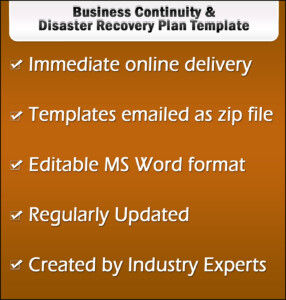BIA, BCP, DRP, EMOP Plan Template Plan
The Business Impact Assessment (BIA) and other template documents are purposely created to identify the key business processes and technology components that would suffer the most significant financial, operational, customer, and/or legal and regulatory loss in the event of a disaster.
Business Impact Analysis
Business Impact Analysis (BIA) is a crucial process undertaken by organizations to assess and evaluate the potential effects of disruptions to their operations. It involves identifying and prioritizing critical business functions, analyzing the impact of disruptions on these functions, and developing strategies to mitigate risks. By conducting a BIA, companies understand the dependencies between different aspects of their operations, enabling them to allocate resources more effectively and prioritize recovery efforts.
One significant aspect of BIA is its role in risk management. By identifying vulnerabilities and potential points of failure within the organization, businesses can proactively implement measures to mitigate risks and enhance their resilience. This proactive approach minimizes the likelihood of disruptions and reduces the severity of their impact should they occur. Moreover, BIA helps businesses comply with regulatory requirements and industry standards by ensuring they have appropriate contingency plans.
Business Continuity Risk Assessment
Business continuity risk assessment is a fundamental process for organizations aiming to mitigate potential disruptions to their operations. This assessment involves identifying and evaluating potential threats, vulnerabilities, and risks that could impact the continuity of business activities. It encompasses various aspects, including natural disasters, cyber-attacks, supply chain disruptions, and operational failures. By conducting a thorough evaluation, businesses can prioritize their resources and develop effective strategies to minimize the impact of potential disruptions.
One key aspect of business continuity risk assessment is understanding an organization’s critical functions and processes. This involves identifying essential operations crucial for the company’s survival and success. By pinpointing these core functions, businesses can allocate resources more efficiently and implement measures to ensure their continuity during adverse events. Understanding dependencies between different functions and processes is vital for developing comprehensive continuity plans that address potential interdependencies and bottlenecks.
Data Center Recovery Plan
A robust data center recovery plan is indispensable for businesses relying on digital infrastructure. It is a comprehensive blueprint for restoring critical operations swiftly and efficiently during unexpected disruptions, whether caused by natural disasters, cyberattacks, or system failures. The plan encompasses meticulous strategies for data backup, redundancy measures, and failover protocols to ensure minimal downtime and data loss. Moreover, it delineates clear roles and responsibilities for designated personnel, establishes communication channels, and delineates escalation procedures to streamline the recovery process.
Furthermore, a well-crafted data center recovery plan prioritizes continuous testing and refinement to validate its efficacy and adaptability to evolving threats and technological advancements. Regular drills and simulations enable organizations to identify vulnerabilities, fine-tune response mechanisms, and enhance overall resilience. Additionally, the plan incorporates post-recovery assessment and documentation provisions to facilitate continuous improvement and compliance with regulatory requirements. By proactively implementing a robust data center recovery plan, businesses can safeguard their operations, mitigate financial losses, and uphold customer trust despite unforeseen disruptions.
Disaster Recovery Plan
A Disaster Recovery Plan (DRP) is a structured approach that outlines procedures to recover and restore critical business operations during a disaster. It encompasses strategies and protocols to mitigate the impact of various disruptions on an organization’s functions and services, such as natural disasters, cyberattacks, or infrastructure failures. The DRP typically includes detailed instructions for assessing risks, establishing priorities, and implementing recovery measures to minimize downtime and data loss. By outlining roles and responsibilities, establishing communication protocols, and regularly testing procedures, a well-designed DRP helps organizations swiftly resume operations, safeguarding their reputation, customer trust, and financial stability in times of crisis.
An effective Disaster Recovery Plan is tailored to an organization’s specific needs and vulnerabilities, taking into account its industry, size, and geographic location. It identifies critical systems, data, and processes, prioritizing their restoration based on their importance to the business’s continuity. Moreover, a comprehensive DRP incorporates redundancy measures, backup solutions, and off-site storage facilities to ensure the availability and integrity of essential resources. Continuous review and updates to the plan are essential to address evolving threats, technological advancements, and organizational changes, enabling businesses to maintain resilience and adaptability in the face of adversity.
Business Continuity Plan
A Business Continuity Plan (BCP) is a comprehensive strategy designed to ensure that an organization can continue operating smoothly and efficiently in the face of unexpected disruptions or disasters. These disruptions could range from natural disasters like earthquakes or floods to human-made crises such as cyber-attacks or supply chain interruptions. The primary goal of a BCP is to minimize downtime, maintain critical functions, and mitigate the impact of disruptions on employees, customers, and stakeholders.
A well-developed Business Continuity Plan typically includes a detailed assessment of potential risks, a clear framework for response and recovery efforts, and specific protocols for communication and decision-making during a crisis. It involves identifying key personnel, establishing alternative work sites, implementing backup systems for essential operations, and regularly testing and updating the plan to ensure its effectiveness. By proactively preparing for various scenarios, organizations can enhance their resilience and safeguard their ability to deliver products and services even in challenging circumstances.
